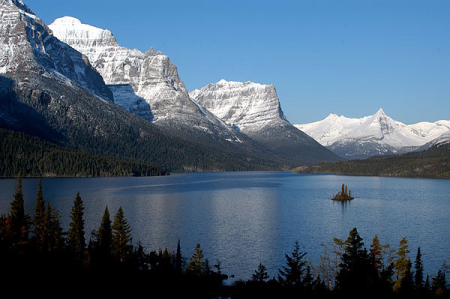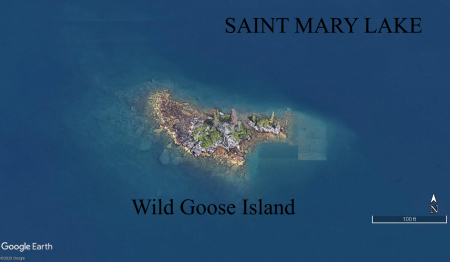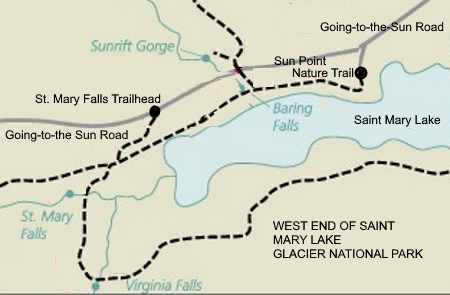Glacier National Park
The glacial landscapes in Glacier National Park were created by large alpine glaciers that covered the region thousands of year ago. As glaciers moved down mountain valleys massive amounts of rock and earth were pushed down slope. Streams flowing from the glaciers carried the sediments to lower elevations.
During geologic time, Divide Creek and Wild Creek, flowing from glaciers in high mountain valleys, deposited huge amounts of sand and gravel in Saint Mary Valley forming a natural dam across the valley. The dam blocked a small stream in the valley. Saint Mary Lake soon formed behind the natural dam.

Saint Mary Lake borders Going-to-the-Sun Road on the south near the east side of the Park. The lake is about 9.9 miles long and, at one point, as much as three-quarters of a mile wide. The lake’s elevation stands at 4,472 feet above sea level. In some areas the lake is around 300 feet deep.
Saint Mary Lake is surrounded by high mountain peaks, making for a beautiful view from most every shoreline. The mountain peaks by themselves are spectacular, carved in ancient geologic time by glaciers that moved down tributary valleys.

The mountains all have catchy names to remember: Red Eagle Mountain, Mahtotopa Mountain, Citadel Mountain, Gunsight Mountain, Goat Mountain, to name a few. Some mountain peaks rise more than 9,000 feet almost touching the clouds floating high above Saint Mary Lake.
During the summer, Saint Mary Lake displays a stunning azure-blue color. This contrasts with the dark green forests which the line the shores and varied-colored mountains which tower above and around the lake a short distance away.
During the winter, deep snows cover mountain peaks. Saint Mary Lake, frozen to a depth of four feet or more, is blanked with snow and becomes a winter wonderland, much like the subject in a child’s fairytale.
As if this splendid scenery were not enough, nature created another gem in the center of the lake. Wild Goose Island. This tiny island stands a mere 14 feet above the lake’s surface and measures only about one-half acre in size. A few trees survive the harsh landscape of the island. Birds often seek Wild Goose Island as a place of refuge.

Glacier National Park officials built Wild Goose Island Lookout off Going-to-the-Sun Road as a place enjoy the scenery and photograph the lake and its surroundings. The lookout is a landscaped gravel area and makes an ideal place to experience the wonderful panorama of Saint Mary Lake.
The lake has more than scenery to offer. Boat tours are eager to take visitors out on the lake. The tours begin from Rising Sun boat dock on Going-to-the-Sun Road. Along the way passengers get a close-up view of Wild Goose Island. A few folks launch on the lake in private boats. Fishing is another common activity. Lake trout, Cutthroat Trout, and Rainbow Trout inhabit the waters of Saint Mary Lake.
Sun Point Nature Trail is in this same area. The trail follows the north shore of Saint Mary Lake west from Going-to-the-Sun Point, a peninsula that juts out into the lake. A little further west is St. Mary Falls Trailhead leading to a couple of scenic waterfalls, St. Mary Falls and Virginia Falls.

Saint Mary Lake and tiny Wild Goose Island are the subjects of countless magazine covers and photographs. Nature truly blessed Saint Mary Lake, its beauty unrivaled anywhere in the world.
If visitors want to spend extra time at Saint Mary Lake, accommodations are close by. Rising Sun Campground and Rising Sun Motor Inn are on Going-to-the-Sun Road a few miles west of the village of St. Mary.

Absaroka Mountain, Mont.
© 2021 John Sandy

